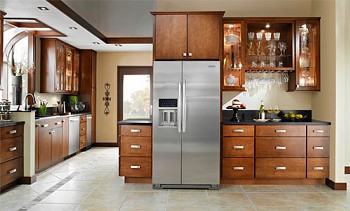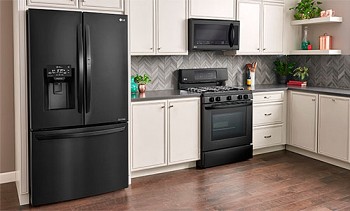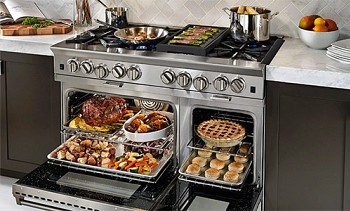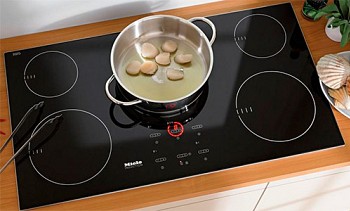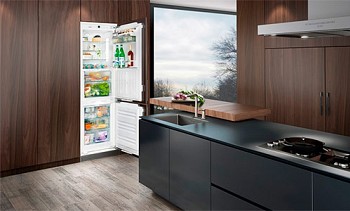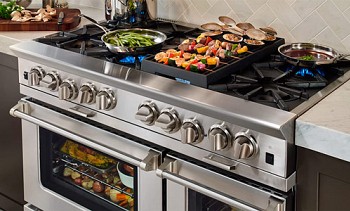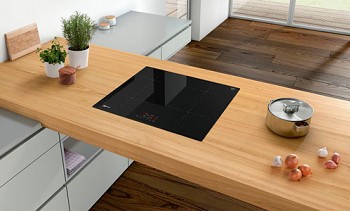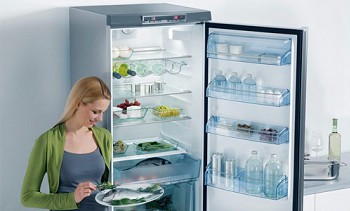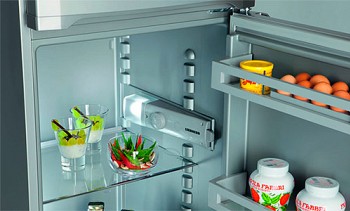The first domestic cooker with induction hobs appeared 30 years ago. Consumers did not immediately appreciate the innovation. Many, however, still do not believe in such a miracle. Manufacturers, despite the skepticism of some potential buyers, continued to improve their products, creating more and more interesting models and endowing them with more and more interesting functions.
It is difficult to remain indifferent at the form of equipment on the market today, and in recent years, interest in induction hobs has increased significantly. More and more consumers are trying to figure out what an induction hob is, what are its pros and cons, on which the principle of its operation is based. Having received answers to these questions, a potential buyer with a high degree of probability can become quite real.
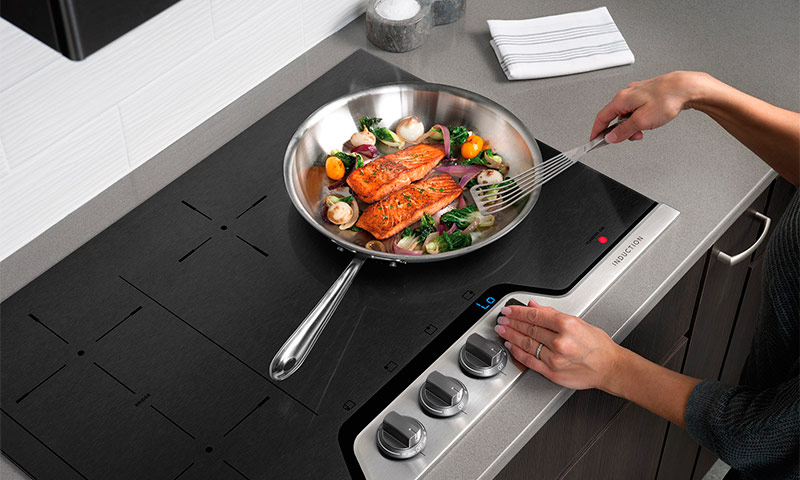
Content:
How does an induction hob work?
What is so special about induction cookers and why many still treat them with some distrust? The fact is that the principle of heating here is completely different from what we are used to observing. As a rule, heating is carried out using a heat source. It can be either a flame (a bonfire or a gas burner), or an electric heater. From the heat source through heat transfer, the dishes are heated, and then its contents.
There is no heat source in the induction cooker. Inductors are hidden under the glass-ceramic panel, which do not heat up when electric current passes (well, or almost never heat up). What is the secret? When an electric current passes through such a coil, an electromagnetic field arises, creating eddy currents in nearby objects from ferromagnetic material (in our case, iron utensils). It is these currents that warm the dishes, and then the food inside is heated from it.

1. Glass ceramic.
2. Copper coil.
3. A magnetic field.
4. Ferromagnetic bottom of the dishes.
As you can see, the idea is simple and witty. True, it is simple only for those who are familiar with physics. Everyone else will just have to believe: it works!
Pros of induction hobs
Induction hobs have perhaps more advantages than household hobs with a different type of heating. They are energy efficient, more convenient to use and more functional.
Low power consumption
Compared to other types of heating elements, the induction panel uses energy very efficiently. Heat is generated not inside the burner, but directly in the bottom of the cookware, resulting in minimal heat loss. If we compare the induction hobs with Hi-Light, then the former are 20-30% more economical, and this is a rather significant difference. Of all induction hobs used today, induction stoves are characterized by the highest efficiency - 90-93% (for electric hobs with cast-iron hobs this value is 53-56%, and for gas burners it is 49-52%).

Induction hob -
Efficiency - 90-93%

Hob with cast-iron hobs -
Efficiency - 53-56%

Gas hob -
Efficiency - 49-52%
Quick heat
No less significant for many buyers, the advantage of induction panels is the high speed of heating pots and their contents. Practice shows that in terms of heating speed they surpass even good gas burners, let alone electric stoves with ordinary cast-iron “pancakes”. This is not even speed, but super-speed.
This feature of induction panels is explained quite simply.During the operation of a traditional burner, the heater first heats up, from it - the surface of the burner itself, the latter already gives off its heat to the pot or pan standing on it.
With the induction heating method, such multistage is absent: the dishes are not heated due to heat transfer, but due to the occurrence of eddy currents in its bottom when an electromagnetic field is applied. It is such a direct, “targeted” effect that ensures fast heating. In addition, the induction hob is characterized by a lightning reaction to any change in mode, which is very popular with the housewives, as this creates ideal conditions for preparing various dishes.
Weak cooking surface
Since there are no heating elements on the induction hob, the temperature of its surface does not rise as much during operation as other types of cookers. The glass-ceramic surface heats up, but only from the bottom of the pot or pan standing on it.
To evaluate, we give a few figures: cast iron burners during operation are heated to 250-280 ° C and more, Hi-Light - almost to 500 ° C, and the surface temperature of the working induction panel does not exceed 80 ° C. (At such low values, the indication of residual heat seems to be a bit redundant, however, almost all modern hobs provide it.)
As you know, this makes working with an induction stove much safer. You will not get burns by accidentally touching the work surface during cooking. This quality, for sure, will be appreciated by families with small children.

Weak surface heating.
Easy care
Due to the low temperature of the hob, food accidentally spilled onto it will not burn. In addition, to wipe the burner, you do not have to wait long for it to cool. This greatly simplifies the process of putting gloss on completion of work, which means that the "escaped" milk will upset you not so much.

You can wipe the escaped milk without turning off the panel.
Convenience cooking
All the housewives who have tested induction cookers in practice are unanimous in the opinion that it is very convenient to cook on them. And it is not only and not so much about high speed and accuracy of heating. Due to the lack of thermal inertia, induction cookers react very sensitively to any changes in settings, including power reduction: when adjustments are made to the mode, the temperature changes almost instantly. The presence of many very useful functions makes cooking a fun and easy process.
Technical advancement
The undoubted advantage of induction hobs is their technical advancement. They can do much more than their "ancestors" with cast-iron burners, and have a number of functions that are not available for other types of hobs.
Would you like some examples to confirm these words? You are welcome…
An induction hob is capable of determining the size and shape of the bottom of a pot or pan placed on it. The current will be supplied only to those coils that are located directly under the bottom of the dishes. In other words, the size of the heating zone automatically adjusts to the area of the dishes. This increases the heating efficiency and efficiency of the device.

In some models, it is no longer necessary to accurately set the dishes along the contour of the burner - it will be quite simple to block the cross in its center. That is why part of the heating zones is indicated quite arbitrarily, for example, by a large rectangular field.

The PowerMove or PowerSlide function allows you to change the heating intensity by simply moving the cookware along the surface of the hob.
This is not all that induction hobs are capable of. But you will still have the opportunity to become more fully acquainted with the functionality of the average induction.
Manufacturers are constantly improving the control system of induction hobs in order to simplify the task of introducing settings to the user, to make this process more intuitive. For some models, for example, these are separate buttons for each power level, which allows you to make settings in one or two touches. Other models have touch sliders that make it possible to select an operating mode by simply swiping a finger along the scale.

More recently, circular sliders have appeared that imitate the work of the rotary knobs that are familiar to everyone. There are, however, more unusual solutions, such as, for example, a control unit with a magnetic removable element Twist Pad.
Most induction hobs provide the ability to lock control buttons - a useful option if the house has small children. But touch screen displays reflecting the operating mode of the device, the settings of individual zones, the location and shape of dishes, etc., are equipped so far with only a few premium induction cookers.
Combined heating zones
In many models of induction hobs, heating zones (burners) can be combined if necessary. This means that they will temporarily work together, as a whole, and have accordingly common settings. This allows you to cook not only in pots and pans of a standard size, but also in bulky dishes (grill pans, frypots, etc.), as well as in irregularly shaped dishes (for example, ducklings). A similar feature is called Bridge.

Determining the availability of dishes
Almost all modern models of induction panels have a function for recognizing the presence of cookware: the burner will not work if there is no cookware on it. Mistresses should now not be afraid that they will forget to turn off the stove at the end of cooking dinner - it will turn itself off as soon as the pan is removed from its surface.
By the way, the panel will not work even if the contact area of the dishes with the hob is too small. This means that you can safely leave a spoon or knife on it - the stove will not turn on and will not start to heat them.
Stop & Go function
The Stop & Go function, which has also become quite common, allows you to pause the cooking process for a while by turning off the cooking zone or switching it to the minimum power level. The hostess can now easily leave the kitchen if necessary, without fear that the dish requiring attention will be spoiled. Pressing the Stop & Go button again, it will resume the process with restoring the settings that exist before the stop.
Pause
The “Cleaning-pause” function allows you to stop the operation of induction coils for 20-30 seconds, so that the user has the opportunity to wipe the control panel, collect crumbled cereals or spilled liquid from the hob. This function has not yet received mass distribution and is found in only a few models.
But blocking the panel from unauthorized changes in settings, in other words, “protection from children,” is in great demand, and therefore it is found on almost all induction cookers.
Intense heat
If necessary, heat the contents of the pan even faster than the induction hob usually does, you can use the intensive heating function (it is called differently by different manufacturers - Power, Booster, Powerboost). At the same time, the power supply to this burner will be increased due to the neighboring burner (of course, the power of the “assistant” will temporarily decrease significantly).
In some models, electricity can be diverted even from not one, but from two adjacent burners (Twin Booster). The power value on the “fed” burner, as a rule, increases to 2.5-3.5 kW, and in some models to previously unthinkable 4.5 kW. For security reasons, this function is limited in time (usually no more than 10 minutes).
Cooking Control Functions
Unfortunately, far from all induction cookers, the control functions available, unfortunately, greatly simplify the cooking process. So, for example, the “Boiling control” function will allow the hostess not to wait near the stove when the contents of the pan that has just been put on the stove warms up. After activating this function and choosing the main cooking mode, you can safely do other things: the hob itself will begin to work at maximum power, and when the water boils, it will switch to the set mode.
Many housewives will appreciate the “Keep Warm” function. The induction panel will maintain a temperature of 40-70 ° C. As a result, the finished dish will not burn out and will not dry out, but will remain warm until the household finally gathers at the dinner table.
Some induction cookers have automatic programs for maintaining the optimum temperature for cooking various products and dishes (eggs, fish, vegetables, soup, etc.).
A timer, which was recently a rarity, today is found in 80% of manufactured induction panels. Moreover, more and more often you can see its more advanced version - a timer with automatic shutdown of the device. There were even economical timers that turned off the heating a little earlier than the appointed time to complete the cooking on the residual heat.
Cons Induction Cooktops
Many users recognize the benefits of induction as a more efficient heating method. Nevertheless, induction panels, which have a huge number of undeniable advantages, are not very popular with Russian buyers so far. What is the reason?
Firstly, induction is an unusual thing for the average person, and therefore causes some caution. Secondly, there are induction hob and cons.
Higher cost
The main disadvantage of induction hobs from the point of view of the average buyer is their high cost. Technically more advanced, more “advanced” induction panels are really more expensive than stoves with Hi Light burners and even more expensive than conventional electric stoves. Just appearing on the market, they scared away many potential buyers at their cost. But time passes, and induction is gradually becoming more affordable pleasure.
In order not to be unfounded, we give a few numbers. The cost of an average induction hob from a well-known manufacturer today is about 20 thousand rubles. There are models that will cost you even less - 10-15 thousand. (Of course, we are not talking about premium-price slabs, the price of which is comparable to the cost of a budget car.) For comparison: a glass-ceramic panel can be purchased for 15-18 thousand. As you can see, there is no reason to break spears.
The difference in the price of induction panels and electric stoves with cast iron burners, of course, is slightly larger. However, it is worth taking into account that by “overpaying” at the stage of purchasing a stove, you will very soon compensate for this difference due to a more economical energy consumption.
Ferromagnetized cookware required
The landlady, who became the owner of the induction hob, will have to reconsider her “park” of kitchenware. Not every pan or pan will fit. The fact is that when using this panel, heating is carried out directly at the bottom of the dishes due to the occurrence of induction currents in it. It is clear that this dishes should be special.
A cook does not have to know the intricacies of physics. Simply, it should be remembered that you can only use dishes whose bottom is made of a material with ferromagnetic properties. Such products are today produced by almost all manufacturers of kitchen utensils and are indicated by a special sign.

Indication of cookware for induction hob.
But what about old dishes? Will you really have to give up your favorite pan or stew-pan? Not at all.Steel and cast iron utensils will still serve you. But from aluminum, copper, brass, glass, ceramic dishes, as well as from dishes made of thin-walled steel or laminated materials, alas, have to refuse. In addition, the bottom of the vessel should be perfectly flat: differences of more than 1 mm are unacceptable.
Checking whether your old, unmarked cookware is suitable for the induction panel is quite easy: just put a regular magnet on the bottom. Holds - it means everything is in order, the dishes "remain in service."
In fact, you do not even have to perform this simple procedure with a magnet. Most induction cooker models have the function of recognizing cookware and will themselves “tell” whether this or that cookware is suitable for them or not. If a pan or pan does not have a ferromagnetic bottom, the panel will simply not start working. As you know, it is impossible to spoil the induction panel by putting something wrong on it: the device simply will not turn on in this case.
Installation restrictions
The installation of an induction hob has some features, and fans who want to install household appliances in accordance with their own ideas about physics and life are advised to still look at the instructions.
Installation of the panel over other household appliances is not allowed (the only exception is an oven manufactured by the same manufacturer and having a built-in cooling fan). It is very important to observe the values of all clearances indicated in the instruction manual.
Close to the induction panel, including in the drawer located under it, it is not recommended to store aerosols and other flammable materials, as well as foil and metal objects.

Do not place metal objects on the surface
The induction cooker reacts to objects made of ferromagnetic materials, so putting metal objects on its surface is not worth it. Many modern models are able to estimate the area of contact with the dishes, and if you put a small object, for example, a knife or a spoon, on the cooking surface, nothing will happen - the stove simply will not respond to the appearance of such a “trifle”. But to store empty pots or pans on the hob, which did not find a place in the cabinet, will have to be weaned.
Limited uptime
The induction panel is designed for continuous operation for only 3 hours. After this time, it will automatically turn off, and if you need it, you will have to turn it on again. This restriction will create some inconvenience for lovers of aspic, which, as you know, needs to be cooked for 6-8 hours.
The effect of induction hobs on the human body
Another barrier to acquiring an induction panel for many potential buyers is the fear of electromagnetic radiation. At the same time, this category of especially cautious citizens for some reason forgets about microwave ovens, televisions, computers and other electrical appliances, the level of electromagnetic radiation of which is not less, and sometimes more, than that of induction cookers.
Talking about the dangers of induction hobs, they do not try to abandon mobile phones that can do much more harm to health, since so many do not part with their gadgets even for a second.
The ideas of modern science about the effects of electromagnetic radiation on the human body can be considered more than limited. The age of electronics, in fact, has just begun, and scientists are not yet able to predict all the adverse effects of this effect on human health in the long term.
That is why WHO adheres to a precautionary policy in this matter. It is not recommended to get too close to the induction hob. This will significantly reduce the risk, because the effect of the electromagnetic field decreases with increasing distance.True, users inevitably have the question: how to cook a dish remotely?
The need for manufacturers to observe a distance of 10-30 cm. True, this does not apply to all users, but to people with pacemakers. As a rule, in the instructions for use, it is recommended that people with similar implantable medical devices consult a doctor. But do doctors know how induction panels work and how their work affects medical devices?
Alternative - Combined Cooktops
Many housewives have already realized all the advantages of induction hobs and are even ready to use them, but they still do not have enough determination to completely abandon burners with a traditional heating method in favor of induction.
If you also belong to this category of doubters and hesitants, you can choose a compromise option - a combined hob. Thanks to it, you, on the one hand, will get the opportunity to join in new technologies, and on the other, retain the right to cook in your favorite cookware on familiar burners.
The most common combination option is to combine induction and Hi-Light burners in one appliance.

Combined hob - induction + Hi-Light.
Another type of combination, induction + gas, also exists, but for obvious reasons it is not in demand, so you will not find a variety of models in this category.

Combination hob - induction + gas
Combined hobs are four- and five-burner. If there are four burners, then their distribution by type is uniform. Induction, however, at the same time, as a rule, the front row is allocated, thereby emphasizing, as it were, "who is the boss in the house." Such a placement has its own logic: operations in which the hostess takes a maximum of participation require flexible changes in settings, and induction is better at handling this.
In the five-burner version, “equality” is impossible, and induction is clearly preferred here: only one, central, burner - Hi-Light.
From a financial point of view, a combination hob cannot be called a winning option. When induction and combination cookers first appeared on the market, the latter were much cheaper. Today the picture has changed: induction has become more affordable and is already inferior to hybrids in price.

+ Pros of Combined Cooktops
- the possibility of using high-speed heating characteristic of induction;
- the ability to continue to use dishes that are not suitable for induction;
- the possibility of using residual heat Hi-Light burners to bring the meal to readiness.

- Cons of combined hobs
- limited selection of models associated with a small number of offers;
- generally higher cost compared to other options;
- limited induction functionality;
- different logic of Hi-Light and induction that requires getting used to.

